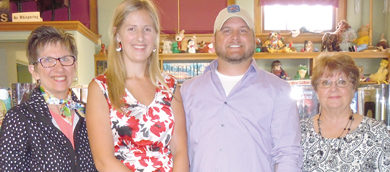World War II veterans honored in Bruning
Five World War II veterans from Bruning were honored at Bruning State Bank Dec. 11 with each receiving a Quilt of Valor (QOV), an organization that has donated hundreds of thousands of quilts to active and retired military servicemen and women since 2005.
Veterans Thomas Kerl, Frank Bruning, Rex Philippi, Gaylord Johnson and Duane Messman were draped in the sturdy quilts with their names on them as QOV Volunteer Phyllis Schoenholz, suggested family members wrap the quilts around their veterans during the presentation.
Kerl was drafted into the army and shipped over to Japan for one year. He served the 3rd Engineers, 24th Division on three different islands. Kerl saw the devastation of Nagasaki and Hiroshima.
“You can’t imagine it. Glass was melted, cement shattered and the trees looked like burnt matchsticks sticking out of the ground. It looked bad,” he said.
Kerl returned home in 1946.
He has been a member of the Bruning American Legion Post 166 for 68 years. His father served in World War I and Kerl provided as much documentation and material as he could for his grandson on the wars.
He said he loves the quilt.
“I really appreciate it. I never knew anything about it before. It was great to be honored,” he said.
Frank Bruning was with the Marine Corp aviation unit when he was stationed in Guam for 14 months as a mechanic, starting in 1945.
Bruning was on the flag crew of a cargo plane that delivered supplies to a variety of islands and into China and Japan.
“I got to see a lot of different countries,” Bruning said.
He was 17 years old when he went in and 20 when he was discharged as a corporal in 1946.
Bruning said the discipline was terrific.
“They (Marine Corp) made men out of boys,” he said.
The government sent him to school and he attended agricultural school for three years, then returned home to farm.
World War II was very well recognized by the public back then, Bruning said.
“I think we were very well honored,” he said.
Bruning added it was different for the veterans who served in Vietnam and Korea, but many people are trying to make up for it.
Rex Philippi helped build roads and bridges for the Army’s 170th Combat Engineer Battalion. He went overseas in 1944, where he spent 30 months.
He said as they were building a bridge in the Phillippines, a bomb dropped, killing 13 men.
“It was the biggest loss we had,” Philippi said.
After the war, Philippi was sent to Korea for occupation duty. He said the weather was much like Nebraska.
“It was too darn cold,” Philippi said.
Following the war, Philippi became a carpenter.
Back then, all carpentry was done by hand, he said. There were no power tools.
In 1973, Philippi bought the Bruning grocery store. It is now operated by his son, Kurt Philippi.
Gaylord Johnson is a Navy man, who was on two different ships and the aircraft carrier, USS Bunker Hill (CV-17). The Seaman First Class, which is now simply titled, Seaman, worked in the mess hall and later in a ship’s office.
Johnson was drafted when he turned 18 years old. He was in on helping troops get to and from Japan. He was drafted in 1944 and discharged in 1946.
He came home and was a substitute mail carrier before taking on the mail route full time for 35 years.
Also a longtime member of the Bruning American Legion, Johnson said the quilt is wonderful and for strong shoulders.
Duane Messman said age, even six months, really made a difference when it came to the war.
He enlisted at 17 years old, but didn’t go until he was 18.
Messman was in boot camp when Japan surrendered. He said they didn’t know what to do with his group, but eventually they were sent to the Naval Station Treasure Island in northern California to unload ammunition from ships that were being decommissioned.
The Seaman First Classman said he would have been in on an invasion of Japan had the war not ended when it did.
He served about 18 months and attended the University of Nebraska-Lincoln for three years. He then came home and farmed.
Messman went on to start Messman Fertilizer. The business has been in operation for 50 years.
Messman said he, Kerl and Johnson were in the same high school graduating class of 1944.
Bruning was a year ahead of them, he said.
The Quilt of Valor project began with Catherine Roberts, a mother who had a son serving in Iraq. She described herself as “10 seconds from panic” during his service.
Roberts began making quilts for soldiers. The first was awarded atWalter Reed Hospital.
The QOV organization awarded its 100,000th quilt in May of 2014.
Schoenholz is the QOV volunteer coordinator for the south central region of the state.
She said Nebraska is the only state to implement the quilt project as a “valor challenge,” Schoenholz said.
The quilts are made by 4H Club members and adults and displayed at the state fair. After the fair, they are donated.
Schoenholz, recently retired from Nebraska Extension in Hebron, said she loved working with 4H members, who were making quilts.
“Their eyes just lit up,” she said.
Since 2011, 4H has made and donated over 300 quilts to veterans.
“When they were shipped to Germany or Afghanistan, we would get the nicest thank you notes from the nurses. The quilts were proudly worn at the Purple Heart ceremonies for the injured. We, as citizens, care,” she said.
The quilts come with matching pillowcases, which are used to carry home hospital and medical forms as soldiers are released from hospitals.


